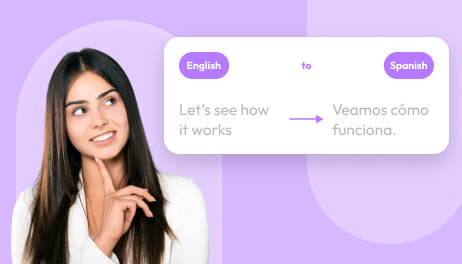Excited to share your thoughts, ideas, and creativity with millions with a YouTube channel? You can simply translate YouTube videos and turn this dream into reality.
Translating your content into different languages allows you to connect with new audiences, increase engagement, and grow your channel faster. But how do you get started?
This piece will guide you through translating YouTube videos step-by-step, providing tips and tricks to help your content stand out globally.
So, let’s jump in!
Why YouTube Video Translation Matters
In today’s interconnected world, YouTube is more than just a platform for sharing videos; it’s a global community where millions of viewers speak different languages. Translating your YouTube videos is crucial for several reasons, and it can significantly impact your channel’s success.
1. Reach a Broader Audience
One of the most compelling reasons to translate your videos is to expand your audience. YouTube boasts over 2 billion users worldwide, many of whom may not speak English.
By providing translations, you can engage viewers from various regions, allowing them to enjoy and understand your content in their native language. This inclusivity not only broadens your reach but also fosters a deeper connection with diverse communities.
2. Boost Viewer Engagement
When viewers can watch your videos in their language, they’re more likely to engage with your content. Translated videos can lead to higher watch times, increased likes, and more shares.
The viewers who engage are also likely to leave comments and subscribe to your channel, helping to grow your community. When your audiences understand the content, they connect better with your message and stay invested in what you’re sharing.
3. Improve SEO and Discoverability
Translating your video titles, descriptions, and tags can significantly enhance your search engine optimization (SEO) results. When you optimize these elements for different languages, your videos become more discoverable in search results across various regions.
This means viewers searching for content in their native language are more likely to find your content, leading to increased views and potential subscribers.
4. Stay Competitive in the Global Market
Offering translated content can set you apart from other creators in an era of fierce competition. Multilingual content helps you reach new audiences and creates a more personalized experience for viewers. Many successful YouTubers already reach international audiences by providing content in multiple languages.
By investing in translations, you position yourself as a creator who values inclusivity and accessibility, making your channel more appealing to a broader audience.
5. Enhance Cultural Relevance
Translation is not just about converting words from one language to another; it’s also about cultural adaptation. It helps ensure that your content resonates with a local audience.
Understanding cultural nuances and context is essential for making your videos relatable and appealing to viewers from different backgrounds.
6. Foster a Global Community
By translating your videos, you invite viewers from around the world to actively engage with your content. They can participate by leaving comments, asking questions, and even sharing their own experiences related to the topic. This interaction can strengthen the bond and connection among diverse audiences.
As your channel grows, you’ll find that people from various cultures share their perspectives, enriching the discussions around your videos.
How to Translate YouTube Videos: The Step-by-Step Guide
Translating your YouTube videos can seem daunting, but with the right steps, you can make your content accessible to a broader audience. Here’s a straightforward, step-by-step guide to help you through the translation process.
Step 1: Choose the Right Translation Method
Before you begin, decide how you want to translate your videos. Here are a few options:
- YouTube’s Auto-Generated Subtitles: YouTube can automatically generate captions for your videos in the original language, which you can then translate into other languages.
- Manual Translation: If you prefer more control over accuracy, consider translating the subtitles yourself or hiring a translator.
- Translation Services: You can use third-party services or tools to help you translate your videos.
Step 2: Access YouTube Studio
- Log in to your YouTube account.
- Tap on your profile picture in the top right corner.
- Select YouTube Studio from the dropdown menu.
Step 3: Navigate to Subtitles
- In the left sidebar, click on Subtitles.
- You’ll see a list of your videos. Find your video to translate and click on it.
Step 4: Add Subtitles Using YouTube’s Tools
- Click on the video: This opens the video’s details.
- Under Subtitles, you’ll see the option to add new subtitles.
- Choose your original language if prompted.
- Click on Add next to Subtitles.
Step 5: Upload or Create Subtitles
You have two options here:
- Upload a File: You can upload a subtitle file (like .srt or .sbv) directly.
- Create New Subtitles: If you want to create subtitles from scratch:
- Click on Create new subtitles.
- Use the Add new subtitles button to type in your translations while watching the video.
- Ensure your timings match the video so that subtitles appear at the right moments.
Step 6: Translate the Subtitles
If you used YouTube’s auto-generated subtitles, follow these steps:
- After you’ve added your original subtitles, return to the Subtitles menu.
- Click on the Add Language button.
- Select the language you want to translate into.
- You’ll see options to either Translate automatically or Create new subtitles.
- If you choose to translate automatically, YouTube will generate translations that you can edit for accuracy.
Step 7: Localize Titles, Descriptions, and Tags
- Go back to the video details in YouTube Studio.
- Click on the Details tab.
- Scroll down to Title and Description. Here, you can enter translations for these fields in the target language.
Step 8: Review and Edit Your Translation
- Watch your video and check that the subtitles appear at the right time.
- Fix if there are any mistakes and ensure your translated texts are easy to read. Pay special attention to cultural nuances and local dialects.
Step 9: Publish Your Translations
- After completing the translations, click Publish in the top right corner.
- Now, your translated subtitles are available for viewers.
Common Mistakes to Avoid When Translating YouTube Videos
Translating YouTube videos can undoubtedly expand your reach, but there are a few common mistakes that can hold you back. Avoid these to ensure translations are smooth and correctly done.
1. Over-rely on Auto-Translation: Auto-generated translations can miss context and create awkward phrases. Always review and edit them for accuracy.
2. Ignoring Cultural Differences: A direct translation might not always work. Be mindful of cultural nuances that could affect how your message is understood in different regions.
3. Skipping Timing Adjustments: Translated subtitles need to sync perfectly with your video. Always check the timing to make sure the subtitles appear at the right moments.
4. Neglecting Video’s Metatags: Only translating the subtitles is not enough. You should translate video’s titles, descriptions and even tags for better discoverability.
5. Not Testing before Publishing: Always preview your video with translated subtitles to catch any errors before making it public.
Try Wavel AI for Enhanced Translations
If you want more faster and accurate result, translate YouTube videos free with Wavel AI. It’s designed to help content creators translate their videos with minimal efforts, yet ensuring high-quality results.
Why Choose Wavel AI?
Wavel AI basically uses advanced artificial intelligence to generate translations in multiple languages. It’s generally easy to use and offers more control over the translation process compared to YouTube’s automatic subtitles.
If you’re translating your videos for global audiences or adding multilingual subtitles, all are done with ease through Wavel AI’s advanced features. You just need to visit Wavel AI Studio and click on Sign Up to get started.
What Wavel AI Offers
- AI-Powered Accuracy: Automatically delivers precise translations with fewer errors.
- 100+ Language Support: Translate your videos into multiple languages like Spanish, French, Hindi, and more.
- Fast Turnaround: Generate translations in minutes, saving time compared to manual methods.
- Customizable Subtitles: Easily adjust fonts, colors, and timing to suit your video.
- Speech-to-Text: Converts speech to text with high accuracy for quick subtitle creation.
- Multi-Language Subtitles: Translate into multiple languages at once for wider audience reach.
- SEO-Friendly: Boosts video ranking in different languages, improving discoverability.
Open Your YouTube Channel to the World
Well, translating your YouTube videos is more than just adding subtitles – it’s about connecting with new audiences, growing your channel, and making your content accessible to viewers everywhere. By avoiding common mistakes and using the right tools, you can ensure that your videos resonate across languages and cultures.
Want to celebrate your global reach? Try Out Wavel AI to get more accurate translations in a few clicks. Don’t miss out – start your free trial today and watch your audience grow!
FAQs
1. Why should I translate my YouTube videos?
Translating your videos helps you connect with more people. It makes your content accessible to non-native speakers, boosts engagement, and can grow your channel by reaching viewers who wouldn’t understand your original language.
2. What tools can I use to translate my videos?
You have some great options! Use YouTube’s built-in subtitle feature, or check out services like Wavel AI for faster, more accurate translations. These tools can really make the translation process simpler and easier.
3. Can I use automated tools for translation?
Yes, you can use automated tools for quick translations, but be cautious. While they save time, they might not always capture context or cultural nuances accurately. It’s better to review and edit any automated translations for the best results.
4. What languages should I choose to translate my videos?
Choose languages based on where your viewers come from. Check your analytics to see popular regions and consider translating into languages that match your audience’s needs.

.webp)






